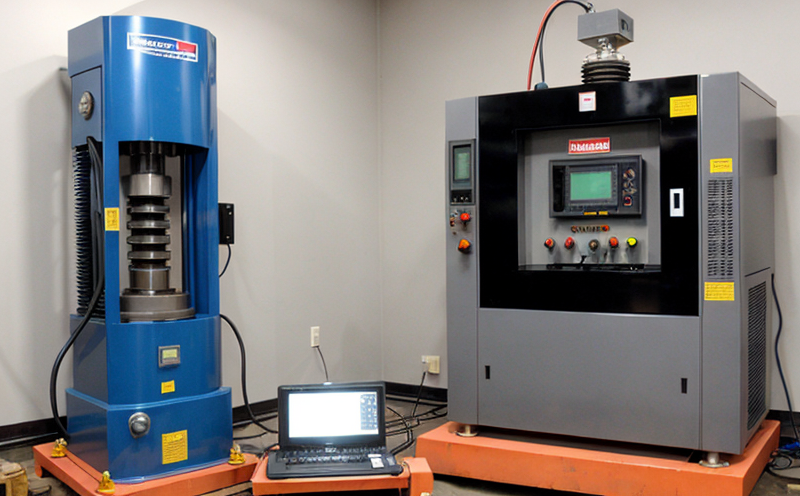MIL STD 810H Method 522 Ballistic Shock Test
The MIL-STD-810H Method 522 ballistic shock test is a critical procedure used to evaluate the durability and resilience of electronic components, assemblies, and systems under sudden, high-energy impacts. This test simulates real-world scenarios where products may experience mechanical shocks due to transportation or operational conditions. The ballistic shock test is particularly important for ensuring that military-grade electronics can withstand harsh environments without compromising performance or reliability.
The test involves exposing the specimen to a controlled impact using a specialized ballistic drop hammer. The purpose of this test is not only to assess structural integrity but also to evaluate functional performance post-impact. This ensures that even after experiencing significant shocks, critical components continue to operate within acceptable parameters and meet specified performance criteria.
The MIL STD 810H standard provides comprehensive guidelines for conducting ballistic shock tests. These include detailed instructions on test setup, specimen preparation, impact conditions, and acceptance criteria. The standard is recognized globally for its rigorous approach to environmental testing, making it a cornerstone in the aerospace, defense, and electronics industries.
The procedure typically starts with careful selection of the appropriate impact energy level based on the product's intended use. The test setup involves positioning the specimen in a controlled environment where precise control over temperature, humidity, and other parameters is maintained to simulate real-world conditions as closely as possible. Once prepared, the specimen undergoes a series of ballistic drops from different angles and heights designed to replicate potential field experiences.
Post-test evaluation focuses on both structural integrity and functional performance. Structural checks involve visual inspections for any visible damage or deformations, followed by non-destructive testing techniques like ultrasonic examination or radiography where necessary. Functional assessments include electrical continuity tests, power supply stability evaluations, and operational performance checks under specified conditions.
Compliance with MIL STD 810H Method 522 is essential for ensuring that products meet stringent quality standards required by the military and other demanding sectors. Failure to comply could result in product rejection or recall, impacting both reputation and cost-effectiveness. By adhering strictly to this method, manufacturers can provide assurance that their products will perform reliably under challenging conditions.
The ballistic shock test is a vital component of any comprehensive quality control program aimed at enhancing reliability and durability in electronic systems. Its role extends beyond mere compliance; it serves as an investment in long-term operational efficiency by reducing maintenance costs and improving overall product lifespan.
Why It Matters
The importance of the MIL STD 810H Method 522 cannot be overstated, especially when considering the critical role electronic components play in modern military operations. These components must operate reliably under extreme conditions, which includes exposure to ballistic shocks. By undergoing this test, manufacturers ensure their products can withstand such impacts without failure.
For quality managers and compliance officers overseeing these processes, adhering to MIL STD 810H ensures that all products meet the highest standards of reliability and durability required by military specifications. This not only enhances product performance but also builds trust with end-users who rely heavily on dependable equipment in critical situations.
R&D engineers benefit significantly from this testing method as it provides valuable insights into how various materials behave under high-energy impacts. Such knowledge aids in material selection, design optimization, and process improvements aimed at enhancing overall robustness against mechanical shocks.
In the realm of procurement, ensuring suppliers meet MIL STD 810H criteria helps organizations select partners capable of delivering high-quality products suitable for demanding applications. This aligns purchasing decisions with broader strategic goals related to quality assurance and operational readiness.
Benefits
The benefits derived from conducting the MIL STD 810H Method 522 ballistic shock test are manifold, offering substantial advantages across multiple stakeholders involved in electronics manufacturing. For end-users, these tests translate into increased confidence that purchased products will function correctly even after experiencing significant mechanical shocks.
From a manufacturer's perspective, compliance with this standard enhances brand reputation by demonstrating commitment to producing robust and reliable products. It also opens up avenues for accessing lucrative markets where stringent quality requirements are paramount, such as the military sector.
R&D teams gain significant advantages through rigorous testing protocols like MIL STD 810H Method 522. They can identify potential weaknesses in design early on, allowing for targeted improvements that enhance product performance and durability. Additionally, insights gained from this process contribute to ongoing innovation efforts aimed at developing next-generation solutions.
For compliance officers responsible for ensuring adherence to regulatory standards, MIL STD 810H provides a clear framework for conducting thorough evaluations of electronic components. This facilitates easier tracking of compliance status while maintaining consistency across different batches or versions of products.
Environmental and Sustainability Contributions
The implementation of MIL STD 810H Method 522 ballistics shock testing contributes positively to environmental sustainability in several ways. By ensuring that electronic components can withstand harsh conditions without compromising performance, this test reduces the likelihood of premature failures leading to unnecessary replacements or repairs.
Manufacturers who follow these stringent standards are better equipped to design products with longer lifespans, thereby minimizing waste generation associated with frequent product turnover. This aligns well with broader sustainability goals aimed at reducing resource consumption and promoting recycling practices.
The testing process itself plays a crucial role in fostering greater awareness among stakeholders about the importance of robust construction techniques that minimize energy consumption during operation. By emphasizing durability over mere functionality, MIL STD 810H encourages manufacturers to adopt more sustainable approaches throughout their product lifecycle.
In addition to direct environmental benefits, adhering to this standard also promotes responsible sourcing practices by encouraging suppliers to provide materials and components that meet rigorous quality standards. This fosters a culture of accountability within supply chains, driving positive change towards greater sustainability across industries.





